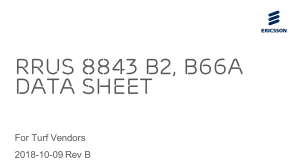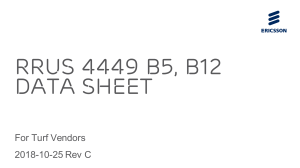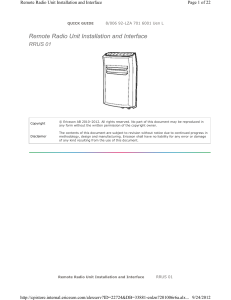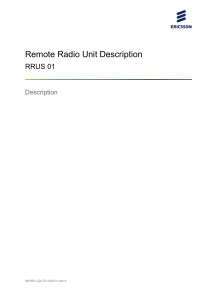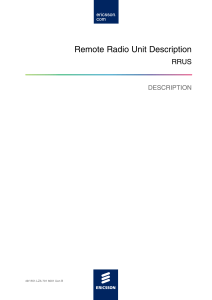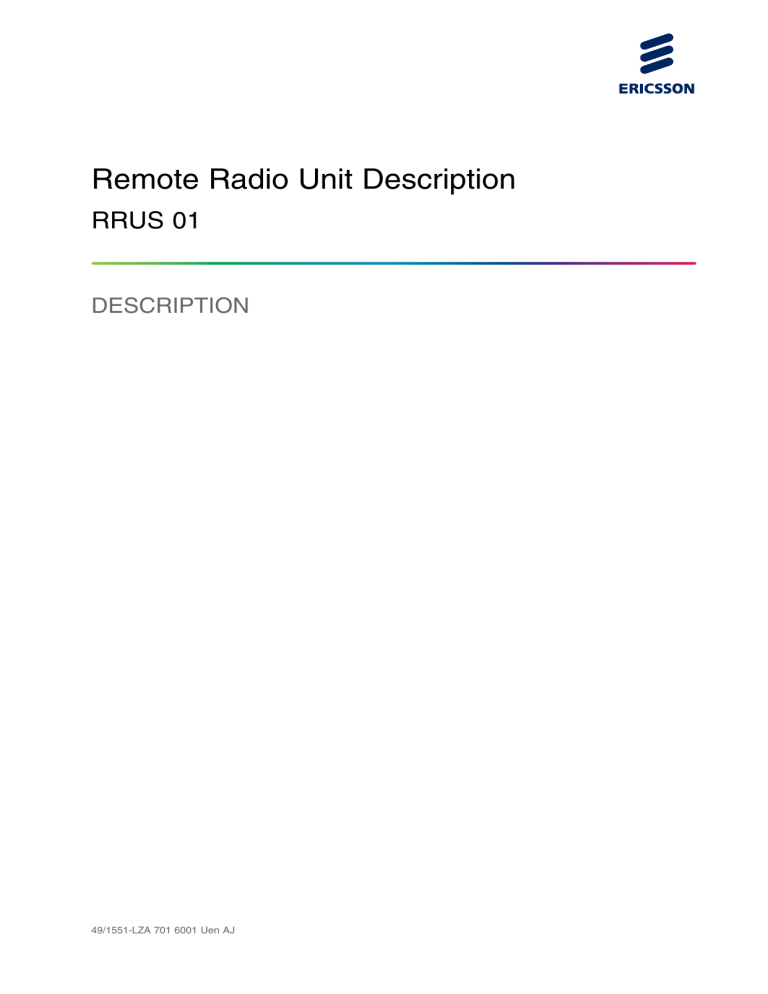
Remote Radio Unit Description RRUS 01 DESCRIPTION 49/1551-LZA 701 6001 Uen AJ Copyright © Ericsson AB 2010–2012. All rights reserved. No part of this document may be reproduced in any form without the written permission of the copyright owner. Disclaimer The contents of this document are subject to revision without notice due to continued progress in methodology, design and manufacturing. Ericsson shall have no liability for any error or damage of any kind resulting from the use of this document. Trademark List All trademarks mentioned herein are the property of their respective owners. These are shown in the document Trademark Information. 49/1551-LZA 701 6001 Uen AJ | 2012-10-11 Contents Contents 1 Introduction 1 1.1 Warranty Seal 1 2 Product Overview 3 2.1 Main Features 4 2.2 Optional Equipment 4 3 Technical Data 5 3.1 Dimensions 5 3.2 Space Requirements 7 3.3 Acoustic Noise 10 3.4 Environmental Characteristics 10 3.5 Mains Supply Characteristics 12 3.6 System Characteristics 15 4 Hardware Architecture 17 4.1 RRUS Overview 18 4.2 Solar Shield 19 4.3 Installation Cover 19 4.4 Optical Indicators and Buttons 19 4.5 Hole for Padlock (Optional) 20 4.6 AC/DC PSU (Optional) 20 4.7 PSU AC 02 (Optional) 21 4.8 RF Monitoring Port (Optional) 22 5 Connection Interfaces 25 5.1 Position A, Maintenance Button 26 5.2 Position B, Optical Indicators 26 5.3 Position C, -48 V DC Power Supply Interface 26 5.4 Position D, LMT 27 5.5 Position E and F, Interface for Optical Cable to Main Unit 27 5.6 Position G and H, Antenna Interface 28 5.7 Position I, ALD Ctrl Interface 28 5.8 Position J, Ext Alarm Interface 28 5.9 Position K and M, RXA I/O and RXB I/O Interface 28 49/1551-LZA 701 6001 Uen AJ | 2012-10-11 Remote Radio Unit Description 5.10 Position L, RXA Out Interface 29 5.11 Position N, Grounding Interface 29 5.12 Optional Equipment Interfaces 30 6 Standards, Regulations, and Dependability 33 6.1 Regulatory Approval 33 6.2 Other Standards and Regulations 35 49/1551-LZA 701 6001 Uen AJ | 2012-10-11 Introduction 1 Introduction This document describes the Remote Radio Unit multi-Standard (RRUS) 01. Note: 1.1 Remote Radio Unit (RRU) is often used as a generic expression for a remotely installed Radio Unit (RU). It is also the name of models prior to the RRUS versions described in this document, for example Remote Radio Unit Wideband (RRUW). Warranty Seal The unit is equipped with a warranty seal sticker. Note: Seals that have been implemented by Ericsson shall not be broken or removed, as it otherwise will void warranty. 49/1551-LZA 701 6001 Uen AJ | 2012-10-11 1 Remote Radio Unit Description 2 49/1551-LZA 701 6001 Uen AJ | 2012-10-11 Product Overview 2 Product Overview The RRUS remotely extends the reach of the RBS by up to 40 km. The RRUS is designed to be located near the antenna. A fiber optic cable connects the RRUS to the RBS main unit or an expanded macro RBS. The RRUSs can be connected in a star configuration or in a cascade configuration with optical cable links as shown in Figure 1. RRUS RRUS RRUS Cascade Configuration RRUS RRUS RRUS Optical Cable Star Configuration Main Unit Ge1103A Figure 1 RRUSs in Star and Cascade Configurations 49/1551-LZA 701 6001 Uen AJ | 2012-10-11 3 Remote Radio Unit Description 2.1 Main Features Depending on the software application, the RRUS supports the Antenna System Controller (ASC), the Tower Mounted Amplifier (TMA), the Frequency Shifting Tower Mounted Amplifier (TMF), or the Remote Electrical Tilt Unit (RETU). The RETU can be connected either through the ASC or the Remote Interface Unit (RIU) over the antenna interface or directly using the RRUS Antenna Line Device (ALD) or Remote Electrical Tilt (RET) control interface. For LTE configurations with dual TX RRUSs, redundancy can be achieved by cross-connecting the antenna feeders between the RRUS and the antenna. For more information, refer to Cross-Sector Antenna Sharing Redundancy. The RET interface on the RRUS is the link to the antenna communication system. See Table 14 for information about the RRUS connection interface for ALD (RET). RRUS 01 supports GSM, WCDMA and LTE FDD (depending on frequency band). It has one duplex RX/TX branch and one uplink RX branch and supports cross connection of RX ports with other RRUs. 2.2 Optional Equipment The optional equipment for the RRUS is the following: 4 • Wall installation equipment • Pole installation equipment • Power Supply Unit (PSU) • Alternating Current Connection Unit (ACCU) • Radio Frequency (RF) monitoring port 49/1551-LZA 701 6001 Uen AJ | 2012-10-11 Technical Data 3 Technical Data This section describes the physical characteristics, environmental data, and the power supply of the RBS. 3.1 Dimensions This section provides technical data and dimensions for the RRUS 01. Table 1 lists the technical data and Figure 2 shows the dimensions for the RRUS. Table 1 RRUS 01 Technical Data Description Value Maximum nominal output power 20 W, 40 W, 60 W, and 80 W (subject to license handling) Number of carriers One to four carriers (subject to license handling) 49/1551-LZA 701 6001 Uen AJ | 2012-10-11 5 Remote Radio Unit Description Description (1) Frequency Value 890 to 915 MHz uplink 935 to 960 MHz downlink B0 for GSM 1,920 to 1,980 MHz uplink 2,110 to 2,170 MHz downlink B1 for WCDMA and LTE 1,850 to 1,910 MHz uplink 1,930 to 1,990 MHz downlink B2 for GSM and WCDMA 1,710 to 1,785 MHz uplink 1,805 to 1,880 MHz downlink B3 for GSM, WCDMA, and LTE 824 to 849 MHz uplink 869 to 894 MHz downlink B5 for GSM and WCDMA 880 to 915 MHz uplink 925 to 960 MHz downlink B8 for GSM and WCDMA 1,749.9 to 1,784.9 MHz uplink 1,844.9 to 1,879.9 MHz downlink B9 for WCDMA and LTE Dimensions without Solar Shield Height 600 mm Width 350 mm Depth 112 mm Dimensions with Solar Shield Height 636 mm Width 383 mm Depth 169 mm Weight 6 49/1551-LZA 701 6001 Uen AJ | 2012-10-11 Technical Data Description Value RRUS 01 20 kg Color Gray (1) Information about Instantaneous Bandwidth (IBW) can be found in RBS Configurations. The RRUS size, height, width, and depth with solar shield, is shown in Figure 2. 383 169 636 Unit of measurement mm Figure 2 3.2 Ge1018A RRUS 01 Height, Width, and Depth with Solar Shield Space Requirements This section describes the space requirements for installing the RRUS. The RRUS with cable connections running downwards can be installed as follows: • On a wall • On a pole Both wall and pole installations can be indoors or outdoors. Pole installations can be on monopoles, masts, or towers. Figure 5 shows sample pole installations. 49/1551-LZA 701 6001 Uen AJ | 2012-10-11 7 Remote Radio Unit Description 3.2.1 Generic Requirements The RRUS is installed with the cable connections facing downwards. Allow a minimum of 1 m free space in front of the RRUS to ensure sufficient working space. Note: If no other possibilities are available, under exceptional conditions, the RRUS may be installed horizontally with the front downwards. This installation alternative limits the power supply options and the maximum output power. Details regarding optional actions can be found in Installing Remote Radio Units. It is recommended that the RRUS is installed below the Antenna. The minimum distance between be RRUS and the antenna must be 200 mm. The installation requirements are shown in Figure 3. Top view Side view Antenna Antenna RRU >0.2 RRU >0,4 RRU Unit of measurement: m Ge3167C Figure 3 Note: 3.2.2 RRUS Installation Requirements The distance between the antenna and the RRU needs to be increased if the antenna azimuth is in the direction of the RRU. Wall Installation The wall must be even within 5 mm/m. The installation requirements are shown in Figure 4. 8 49/1551-LZA 701 6001 Uen AJ | 2012-10-11 >200 >200 >300 >1000 >400 Technical Data Unit of measurement: mm Figure 4 3.2.2.1 Ge1310A RRUS Wall Installation Requirements Site Layout To ensure adequate airflow between the units, allow a minimum of 400 mm free space above and 300 mm free space minimum below each RRUS. Allow a minimum of 200 mm free space between RRUSs installed side by side. 3.2.3 Pole Installation The supported pole diameters are listed in Table 2. Table 2 3.2.3.1 Pole Diameters Mounting Equipment Pole Diameter Supported RRUSs Single fixture 60 – 120 mm All types Mounting bracket 35 – 155 mm All types Site Layout Allow a minimum of 200 mm free space between RRUSs installed side by side. To ensure adequate airflow between the units, allow a minimum of 400 mm free space above and 300 mm free space below each RRUS. Note: For an RRUS with AC power supply, the mounting bracket supports only two RRUS units. 49/1551-LZA 701 6001 Uen AJ | 2012-10-11 9 Remote Radio Unit Description Figure 5 shows example pole installations (left to right: single unit on a monopole, two units on a tower on different struts, and three units on a monopole). Ge1311A Figure 5 3.3 Sample Site Layout for Pole Installation Acoustic Noise The RRUS does not generate acoustic noise. 3.4 Environmental Characteristics This section contains RRUS operating environment data. 3.4.1 Operating Environment The following is a list of values for the RRUS normal operating environment: Temperature -40 to +55 C -40 to +45 C (RRUS 01 B2 and B3 in high load scenario: 80 W) 10 Solar radiation ≤ 1,120 W/m² Relative humidity 5 to 100% Absolute humidity 0.26 to 40 g/m3 Maximum temperature change 1.0C/min Maximum wind load at 50 m/s (pole installed single case) 480 N (front) 49/1551-LZA 701 6001 Uen AJ | 2012-10-11 Technical Data 3.4.2 Heat Dissipation The RRUS is convection cooled. The heat dissipation value shown in Table 3 is meant to give an idea of heat dissipation when the unit is installed alone or around other RRUs. The value represents the maximum power consumption of an RRUS, taking into account optional equipment and future expansions. Table 3 RRUS Heat Dissipation Unit Output Power Maximum Heat Dissipation RRUS 01 60 W 0.32 kW RRUS 01 80 W 0.35 kW For power consumption values during traffic, see Table 8. 3.4.3 Vibration This section describes the RRUS tolerance to vibrations. The RRUS operates reliably during seismic activity as specified by test method IEC 60 068-2-57 Ff. Maximum level of Required Response Spectrum (RRS) 50 m/s2 within 2-5 Hz for DR=2% Frequency range 1–35 Hz Time history signal Verteq II The RRUS operates reliably during random vibration as specified by test method IEC 60 068-2-64 Fh method 1 Random vibration, normal operation 0.5 m2/s3 The RRUS operates reliably during shock as specified by test method IEC 60 068-2-27 Ea 3.4.4 Peak acceleration 40m/s2 Duration 22 ms Materials All Ericsson products fulfill the legal and market requirements regarding: • Material declaration • Fire resistance, components, wires, and cables of materials • Recycling 49/1551-LZA 701 6001 Uen AJ | 2012-10-11 11 Remote Radio Unit Description • 3.5 Restricted and banned material use Mains Supply Characteristics This section describes the power supply requirements, power consumption, and fuse and circuit breaker recommendations for the RRUS. The power for multiple RRUSs can be supplied from different power systems if required. 3.5.1 DC Power Supply Characteristics The power supply voltage for the RRUS is -48 V DC. The power supply requirements are listed in Table 4. Table 4 RRUS DC Power Supply Requirements Conditions Values and Ranges Nominal voltage -48 V DC Operating voltage range -40.0 to -57.6 V DC Non-destructive range 0 to -60 V DC Fuse and Circuit Breaker Recommendations External fuse and circuit breaker capabilities for the RRUS are listed in Table 5. The recommendations given in this section are based on peak power consumption and give no information on power consumption during normal operation. The recommended melting fuse type is gG-gL-gD in accordance with IEC 60269-1. Circuit breakers must comply with at least Curve 3 tripping characteristics, in accordance with IEC 609 34. The RRUS has a built-in Class 1 (Type 1) Surge Protection Device (SPD) to protect the equipment in case of lightning and network transients. The recommended fuse or circuit breaker rating is therefore dimensioned for not tripping the fuse or circuit breaker in case of SPD operation. The minimum fuse rating could be taken into account only if it is accepted that fuses or circuit breakers trip in such situations. 12 49/1551-LZA 701 6001 Uen AJ | 2012-10-11 Technical Data Table 5 RRUS Fuse or Circuit Breaker Recommendations Unit (DC Powered) Output Power Minimum Fuse (1) Rating Fuse Rating Recommended for Reliable (2) Operation Maximum Allowed Fuse (3) Rating RRUS 01 80 W 14 A 25 A 32 A 60 W 13 A 40 W 8A 20 W 6A (1) These fuse ratings can only be used if it is acceptable that fuses trip due to lightning or network transients. (2) The recommended fuse rating takes into account the fact that external fuses are not to trip due to lightning or network transients. (3) The absolute maximum fuse class in accordance with RRUS design restrictions. 3.5.2 AC Power Supply Characteristics The RRUS AC accepts 100 to 250 V AC if it is used together with the optional PSU. The power supply requirements are listed in Table 6. Table 6 RRUS AC Power Supply Requirements Normal Voltage Range Tolerance Range 200 to 250 V 180 to 275 V AC (1) 100 to 127 V 108 to 130 V AC (1) 100 V 90 to 110 V AC Connection Phase-neutral Frequency range 50 to 60 Hz Voltage harmonics < 10% at full load Shut-off allowance At undervoltage or overvoltage Inrush current peak < 40 A Inrush current duration < 10 ms (1) (2) (3) (1) AC connected through ACCU optionally and PSU (2) Must comply with IEC 61000-3-2 (3) Alarm raised at 70 ± 5 V, ceased at 80 ± 5 V (phase voltage) Fuse and Circuit Breaker Recommendations External fuse and circuit breaker capabilities for the RRUS are listed in Table 7. The recommendations given in this section are based on peak power consumption and gives no information on power consumption during normal operation. 49/1551-LZA 701 6001 Uen AJ | 2012-10-11 13 Remote Radio Unit Description The recommended melting fuse type is gG-gL-gD in accordance with IEC 60269-1. Circuit breakers must comply with at least Curve 3 tripping characteristics, in accordance with IEC 609 34. The ACCU and PSU AC 02 have a built-in Class 1 (Type 1) SPD to protect the equipment in case of lightning and network transients. The recommended fuse or circuit breaker rating is therefore dimensioned for not tripping the fuse or circuit breaker in case of SPD operation. The minimum fuse rating could be taken into account only if it is accepted that fuses or circuit breakers trip in such situations. The PSU AC 02 and the ACCU are described in Section 4.6 on page 20 and Section 4.6.1 on page 20. Table 7 RRUS Fuse/Circuit Breaker Recommendations (1) Unit (AC powered) Minimum Fuse Rating RRUS 01 60 W and 80 W • 7 A (100 to 127 V AC) Fuse Rating Recommended for (2) Reliable Operation Maximum Allowed(3)Fuse Rating 32 A 32 A • 4 A (200 to 250 V AC) (1) These fuse ratings can only be used if it is acceptable that fuses trip due to lightning or network transients. (2) The recommended fuse rating takes into account the fact that external fuses are not to trip due to lightning or network transients. (3) The absolute maximum fuse class in accordance with RRUS design restrictions. 3.5.3 Power Consumption This section contains RRUS power consumption data. The power consumption data listed in this section refer to normal operation during traffic. Typical power consumption values are based on a realistic, typical traffic distribution that corresponds to an average output power of 40%. Cooling conditions are based on an annual temperature distribution for the Frankfurt am Main (Germany) climate zone. Optional equipment is not included. The high-load power consumption values corresponds to 100% of the maximum output power. Cooling conditions are based on a statistical maximum temperature for the Frankfurt am Main (Germany) climate zone (+30 C). Optional equipment is not included. Table 8 shows RRUS power consumption. Table 8 RRUS Power Consumption Values Unit Output Power Typical Power(1) Consumption High Load Power (1) Consumption RRUS 01 60 W 0.22 kW 0.38 kW RRUS 01 80 W 0.30 kW 0.43 kW (1) The power consumption values do not include power to optional external equipment such as RET TMA, and TMF. 14 49/1551-LZA 701 6001 Uen AJ | 2012-10-11 Technical Data 3.6 System Characteristics This section describes the system characteristics of the RBS. 3.6.1 RF Electromagnetic Exposure for RBS 6000 General information on RF Electromagnetic Fields (EMF) for RRUSs connected to an RBS from the 6000 family can be found in Radio Frequency Electromagnetic Fields. Information about radio access specific compliance boundaries for electromagnetic exposure can be found in Radio Frequency Electromagnetic Exposure. 3.6.2 Software Information on software dependencies can be found in Compatibilities for Hardware and Software. 3.6.3 Radio Configurations Information about available radio configurations can be found in RBS Configurations. 49/1551-LZA 701 6001 Uen AJ | 2012-10-11 15 Remote Radio Unit Description 16 49/1551-LZA 701 6001 Uen AJ | 2012-10-11 Hardware Architecture 4 Hardware Architecture This section describes the RRUS hardware structure regardless of configuration or frequency. The RRUS components are shown in Figure 6 and listed in Table 9. Note: The supported configurations are described in RBS Configurations. A B E D C Ge1019C Figure 6 Table 9 RRUS 01 Components Key to RRUS Components Position Component A Solar shield B PSU (optional) C ACCU (optional) D Installation cover E Hole for padlock 49/1551-LZA 701 6001 Uen AJ | 2012-10-11 17 Remote Radio Unit Description 4.1 RRUS Overview The RRUS contains most of the radio processing hardware. The following sections describe the component units inside the RRUS. 4.1.1 TRX The Transmitter and Receiver (TRX) provides the following: 4.1.2 • Analog/Digital (A/D), Digital/Analog (D/A) conversion • Channel filtering • Delay and gain adjustment • Digital predistortion • RF modulation and demodulation • Optical cable interface termination • Two receivers for RX diversity • RET receiver (the antenna system communication link) PA The Power Amplifier (PA) is the linear power amplifier for the RF carrier. The RRUS has one PA. 4.1.3 FU The Filter Unit (FU) consists of band-pass filters and low-noise amplifiers. In the RRUS, the FU also provides the following: 4.1.4 • Power and supervision for the ASC, the TMA, the TMF, or the RIU • Voltage Standing Wave Ratio (VSWR) supervision DC SPD The DC SPD board protects the DC power input from lightning currents. 4.1.5 ALD (RET) SPD An SPD provides overvoltage/overcurrent protection for the ALD (RET) port. 18 49/1551-LZA 701 6001 Uen AJ | 2012-10-11 Hardware Architecture 4.1.6 External Alarm SPD An SPD provides overvoltage/overcurrent protection for the external alarm ports. 4.2 Solar Shield The solar shield protects the RRUS from solar radiation. The solar shield is also part of the cooling design. Figure 6 shows the solar shield. Note: 4.3 Always attach the solar shield to the RRUS regardless of whether the RRUS is installed in a shady or in a sunny location. Installation Cover The installation cover hides, for example, the optical indicators. More information can be found in Section 5 on page 25. 4.4 Optical Indicators and Buttons The RRUS is equipped with optical indicators that show system status. The optical indicators are located underneath the installation cover. Table 10 describes how to interpret the optical indicators for RRUS when WCDMA and LTE controlled. Table 10 Marking RRUS Optical Indicators WCDMA or LTE Controlled Indicator Color Mode Indicates Fault Red Off No fault detected in RRUS On Fault detected in RRUS Off RRUS not operational On Power present Blink (2 Hz) Load or testing in progress Blink (0.5 Hz) Dependent resource missing Off RRUS not in maintenance mode On RRUS in maintenance mode Blink (0.5 Hz) Shutdown in progress Operational Maintenance 49/1551-LZA 701 6001 Uen AJ | 2012-10-11 Green Blue (1) 19 Remote Radio Unit Description Marking 1, 2 LMT Indicator Color Mode Indicates Interface Green Off Disconnected On Connected – – – Not used Maintenance – – Switch RRUS mode between Remote and Maintenance Button: (1) The color can also be yellow. The yellow optical indicator can blink busy. 4.4.1 Maintenance Button Function For WCDMA and LTE, the maintenance button can be used to lock, unlock, or restart an RU. More information about the functions can be found in Indicators, Buttons, and Switches. 4.5 Hole for Padlock (Optional) The RRUS solar shield can be locked by inserting a padlock through the hole. 4.6 AC/DC PSU (Optional) The AC/DC PSU is required for the AC power input option. The AC/DC PSU converts RRUS input main power 100 - 250 V AC to -48 V DC and is installed on the back of the RRUS. Figure 7 shows the AC/DC PSU. Ge1349A Figure 7 4.6.1 AC/DC PSU Showing AC Connector (Blowup) and DC Cable ACCU (Optional) The ACCU is required when the PSU is used and the RRUS is installed outdoors. The ACCU houses the SPD and is installed on the back of the RRUS. The ACCU components are shown in Figure 8 and listed in Table 11. 20 49/1551-LZA 701 6001 Uen AJ | 2012-10-11 Hardware Architecture A C B Ge0659B Figure 8 ACCU Table 11 ACCU Overview Position Interface A AC power supply cable (input gland) B Grounding C AC power RF cable to AC/DC PSU Note: 4.7 The wire color code for the external AC power supply cable is market dependent. PSU AC 02 (Optional) The PSU AC 02 can replace the PSU AC described in Section 4.6 on page 20 and the PSU AC 02 has a built-in SPD which means that no ACCU is needed. The PSU AC 02 components are shown in Figure 9 and listed in Table 12. A C D B Ge1673A Figure 9 PSU AC 02 49/1551-LZA 701 6001 Uen AJ | 2012-10-11 21 Remote Radio Unit Description Table 12 PSU AC 02 Connection Interfaces Position Interface A Grounding interface B AC power interface C Interface for future use D DC power interface For more information about PSU AC 02, see PSU Description. 4.8 RF Monitoring Port (Optional) The RF monitoring port can be used to monitor the RRUS downlink RF output power without interrupting service. The RF monitoring port components are shown in Figure 10 and listed in Table 13. A 11 0 C B Unit of measurement: mm Figure 10 Table 13 Ge1400B RF Monitoring Port RF Monitoring Port Overview Position Interface A 7/16 RF connector used for connecting to B 7/16 RF connector for connecting the RF cable C N-type RF connector for pairing with connector on monitoring equipment (including metal protective cap to be used when the interface is not in use) interface The RF monitoring port is connected to the antenna interface on the RRUS connection interface panel at the bottom of the RRUS. The interface supports bidirectional, RX/TX traffic, but only the TX direction can be monitored. 22 49/1551-LZA 701 6001 Uen AJ | 2012-10-11 Hardware Architecture Using the RF monitoring port does not affect RRUS performance. RF leakage due to connecting the antenna cables through the monitoring port does not exceed that of a standard RF cable. Insertion loss between port A and port B is less than 0.2 dB. 49/1551-LZA 701 6001 Uen AJ | 2012-10-11 23 Remote Radio Unit Description 24 49/1551-LZA 701 6001 Uen AJ | 2012-10-11 Connection Interfaces 5 Connection Interfaces This section contains information about the RRUS connection interfaces. The RRUS connection interfaces are shown in Figure 11, and listed in Table 14. A B D 1 LMT 2 1 E 2 F C D E F I G J K H L M N Ge1041B Figure 11 Table 14 RRUS 01 Connection Interfaces RRUS Connection Interfaces Positi on Description A Maintenance button 49/1551-LZA 701 6001 Uen AJ | 2012-10-11 Marking 25 Remote Radio Unit Description 5.1 Positi on Description B Optical indicators Marking , , 1, 2 C -48 V DC power supply D – E Optical cable 1 1 F Optical cable 2 2 G Antenna 1 H Antenna 2 I ALD (used for a RET unit for example) ALD Ctrl J External alarm EXT Alarm K Cross connect RXA RXA I/O L RXA co-site RXA Out M Cross connect RXB RXB I/O N Grounding LMT Position A, Maintenance Button See Indicators, Buttons, and Switches for information about maintenance button. 5.2 Position B, Optical Indicators Optical indicators show the system status. More information about the optical indicators can be found in Indicators, Buttons, and Switches or in Section 4.4 on page 19. 5.3 Position C, -48 V DC Power Supply Interface The -48 V DC power connection is made through a connector. The connector accepts cables with various cross-sectional areas depending on the cable length. These cross sectional diameter tolerances are listed by cable length in Table 15. 26 49/1551-LZA 701 6001 Uen AJ | 2012-10-11 Connection Interfaces Table 15 -48 V DC Power Supply Cable Diameter Tolerances Cable Length Recommended Cross-Sectional Area of Each Conductor 0 to 60 m 6 mm2 60 to 100 m 10 mm2 The power cable conductor has a wire for the 0 V conductor and a wire for the -48 V conductor. The wire color code for both is market dependent. All cables must be shielded. The shielding must be properly connected both to the power connector and to the grounding interface in the power supply equipment, otherwise the RRUS overvoltage and lightning protection do not function properly. 5.4 Position D, LMT Not used. 5.5 Position E and F, Interface for Optical Cable to Main Unit The 1 and 2 cables carry traffic and timing signals between the RRUS and the main unit. An Small Form-factor Plugable (SFP) is used to connect the optical cable to the RRUS. Note: The RRUS uses SFP modules for optical transmission and optical radio interfaces on Data 1 (optical cable 1 in) and Data 2 (optical cable 2 out). Only use SFP modules approved and supplied by Ericsson. These modules fulfill the following: • Compliance with Class 1 laser product safety requirements defined in standard IEC 60825-1. • Certification according to general safety requirements defined in standard IEC 60950-1. • Functional and performance verified to comply with RBS specifications. Recommended SFP modules are obtained from the product packages for the RBS and the Main Remote Installation products. See Spare Parts Catalog and Main-Remote Installation Products Overview for more information. 49/1551-LZA 701 6001 Uen AJ | 2012-10-11 27 Remote Radio Unit Description 5.6 Position G and H, Antenna Interface The antenna interfaces provide RRUS connections to antennas. RF cables connect the RRUS to the antenna. The antenna connection interface characteristics of these cables are described in Table 16. Table 16 RRUS Antenna Connection Interface Characteristics Connector Type RF Cable Type 7/16 IEC-169-4 50 1/2-inch insert-receiver coaxial type Cable Connector Type Cable Product Number 7/16 insert-type on both ends TSR 951 70 The antenna cables must be connected as described in Table 17. Table 17 RRUS Antenna Cable Connectors RRUS Connectors 5.7 Antenna Connectors (Antenna 1) TX/RX (Antenna 2) RX Position I, ALD Ctrl Interface The ALD control (ALD Ctrl) connects an ALD (RET) cable to the RRUS for antenna system communication. 5.8 Position J, Ext Alarm Interface Two external alarms can be connected to the RRUS external alarm port. RRUS external alarms are currently supported in WCDMA and LTE. 5.9 Position K and M, RXA I/O and RXB I/O Interface The RXA I/O and RXB I/O interface port is used to cross connect the RRUS for antenna diversity. Figure 12 shows cross connection of RRUSs. 28 49/1551-LZA 701 6001 Uen AJ | 2012-10-11 Connection Interfaces RXA I/O RXB I/O RRU 1 RRU 2 Ge1020A Figure 12 5.10 Cross Connecting RRUS Position L, RXA Out Interface The RXA Out interface port is used to co-site RRUSs. RXA Out RXB I/O Ge1021A Figure 13 5.11 Co-siting RRUS Position N, Grounding Interface The RRUS must be grounded to protect it from overvoltage and lightning strikes. The grounding interface on the RRUS accepts a small cable lug on a short, coated cable. The cable and loop is then bolted into place with an M8 bolt as shown in Figure 14 . 49/1551-LZA 701 6001 Uen AJ | 2012-10-11 29 Remote Radio Unit Description Socket 13 mm 15 Nm Ge1016C Figure 14 5.12 Grounding Interface Optional Equipment Interfaces The equipment presented in this section is optional and can be ordered separately. 5.12.1 PSU AC (Optional) The PSU (also called the PSU AC) uses an AC power interface available from Ericsson. The AC cable is connected to the PSU with a contact on the cable. Ericsson can supply a cable kit in different sizes where the AC contact is already attached. All cables must be shielded. The shielding must be grounded on both the PSU and the power supply equipment side with the site Main Earth Terminal (MET). Each power cable conductor can have a 1.5–4 mm² cross-sectional area. The PSU is shown in Figure 7 or Figure 9. Note: An ACCU is required with the PSU when the RRUS is installed outdoors. The wire color code in the external AC power supply cable is market dependent. 30 49/1551-LZA 701 6001 Uen AJ | 2012-10-11 Connection Interfaces 5.12.2 ACCU (Optional) The ACCU uses a screw plinth interface. All cables must be shielded. The shielding must be connected to the site MET on both ends. Each power cable conductor can have a 1.5–4 mm² cross-sectional area. The ACCU must be grounded to protect it from overvoltage and lightning strikes. The ACCU is shown in Figure 8. 5.12.3 RF Monitoring Port (Optional) The optional RF monitoring port allows either periodic or continuous downlink RF output power monitoring without interrupting RRUS service. The monitoring interface can be found on the optional RF monitoring port. The RF monitoring port can be placed on each antenna interface that is a transmitter port. 32 mm 25 Nm Ge1017B Figure 15 RF Monitoring Interface Connection 49/1551-LZA 701 6001 Uen AJ | 2012-10-11 31 Remote Radio Unit Description 32 49/1551-LZA 701 6001 Uen AJ | 2012-10-11 Standards, Regulations, and Dependability 6 Standards, Regulations, and Dependability This section presents a brief overview of standards, regulatory product approval, and declaration of conformity. Declaration of Conformity A signed Supplier's Declaration of Conformity (SDoC) for the European market is available on request. 6.1 Regulatory Approval The RBS complies with the following market requirement: • EC market requirements, R&TTE Directive1999/5/EC 0168 Alert Mark (Class 2 equipment) Restrictions to use the apparatus may apply in some countries or geographic areas. An individual license to use the specific radio equipment may be required. The apparatus may include radio transceivers with support for frequency bands not allowed or not harmonized within the European Community (EC). • 6.1.1 FCC and ETL approval Safety Standards Compliance In accordance with market requirements, the RBS complies with the following product safety standards and directives: • IEC 60 950-1:2005, Ed. 2 (worldwide) • IEC 60 215 (1987) (worldwide) • EN 60 215:1989 (applicable for systems used in the EU) • EN 60 950-1:2006, Ed. 2 (applicable for systems used in the EU) • UL 60950-1:ed.2 / CSA-C22.2 No.60950-1-07:ed.2 (Applicable for systems used in North America) 49/1551-LZA 701 6001 Uen AJ | 2012-10-11 33 Remote Radio Unit Description 6.1.1.1 RRUS-Specific Safety Standards In accordance with market requirements, the RRUS complies with the following product safety standards and directives: 6.1.2 • IEC 60950-22:2005 (worldwide) • EN 60950-22:2006 (applicable for systems used in the EU) • UL 60950-22 / CSA-C22.2 No. 60950-22-07 (applicable for systems used in North America) • IEC 60529 (IP55) (worldwide) • EN 60529 (IP55) (applicable for systems used in the EU) • UL 50E Ed. 1 2007 / CAN/CSA-C22.2 NO. 94.2-07, type 3R (applicable for systems used in North America) EMC Standards Compliance The RBS complies with the following standards regarding Electromagnetic Compatibility (EMC): 6.1.3 • 3GPP TS25.113 (worldwide) • 3GPP TS36.113 (worldwide) • 3GPP TS37.113 (worldwide) • ETSI EN 301 489-1 (applicable for systems used in the EU) • ETSI EN 301 489-8 (applicable for systems used in the EU) • ETSI EN 301 489-23 (applicable for systems used in the EU) • FCC CFR 47 part 15 (applicable for systems used in North America) Radio Standards Compliance The RBS complies with the following standards regarding radio: 34 • 3GPP TS25.141 (worldwide) • 3GPP TS36.141 (worldwide) • 3GPP TS37.141 (worldwide) • ETSI EN 301 502 (applicable for systems used in the EU) • ETSI EN 301 908-1 (applicable for systems used in the EU) 49/1551-LZA 701 6001 Uen AJ | 2012-10-11 Standards, Regulations, and Dependability 6.1.4 • ETSI EN 301 908-3 (applicable for systems used in the EU) • ETSI EN 301 908-14 (applicable for systems used in the EU) • ETSI EN 301 908-18 (applicable for systems used in the EU) • FCC CFR 47 part 2X (applicable for systems used in North America, X is Frequency band dependent) Marking To show compliance with legal requirements, the product is marked with one of the following: 6.1.5 • CE mark (applicable for systems used in the EU) • FCC and ETL mark (applicable for systems used in North America) Type Approval Standards The RRUS complies with EC requirements regarding radio performance. The product bears the CE mark to show compliance with the legal requirements of the relevant region. 6.1.6 RoHS The RRUS complies with Restriction of Hazardous Substances in Electrical and Electronic Equipment (RoHS) Directive (2002/95/EC). 6.2 Other Standards and Regulations The standards and regulations in this section are not regulatory approved. 6.2.1 Dependability The RRUS is designed for a mean time between failures of 50 years at 20C (24-hour operation). 6.2.2 Spare Parts This RRUS complies with the Ericsson Serviceability and Spare Parts Strategy. 49/1551-LZA 701 6001 Uen AJ | 2012-10-11 35 Remote Radio Unit Description 6.2.3 Surface Quality The surface quality of the RRUS is in accordance with Ericsson standard class A3. 6.2.4 Vandal Resistance Unauthorized access is not possible without damaging the unit. 36 49/1551-LZA 701 6001 Uen AJ | 2012-10-11
